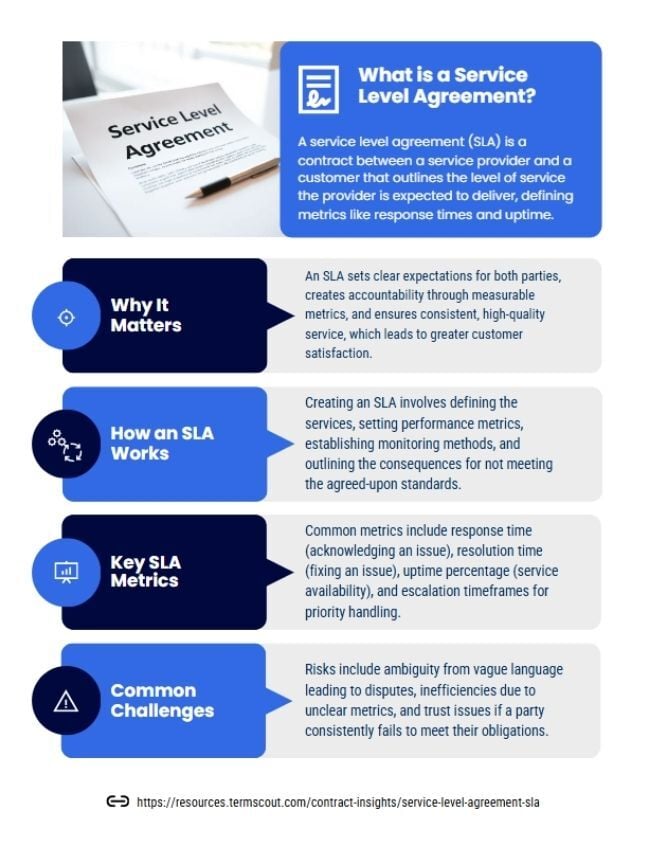Service level agreements (SLAs) are crucial for businesses looking to establish clear expectations and accountability with their partners or service providers. Without a well-defined SLA in place, companies risk misunderstandings, missed deadlines, and ultimately, damaged relationships. In today's fast-paced business environment, having a solid SLA is essential for ensuring smooth operations and successful collaborations.
In simple terms, SLA meaning refers to a formal commitment between provider and customer that sets clear performance standards and service expectations.
What is Service Level Agreement?
A service level agreement (SLA) is a contract between a service provider and a customer that outlines the level of service that the provider is expected to deliver. It defines the metrics by which the service will be measured, such as response times, uptime, and resolution times.
Why It Matters
Having a well-defined SLA is important for businesses for several reasons:
- Clear Expectations: An SLA helps both parties understand what is expected of them, reducing the likelihood of misunderstandings.
- Accountability: With measurable metrics in place, both parties can hold each other accountable for meeting their obligations.
- Quality Assurance: SLAs ensure that the service provider consistently delivers high-quality service, leading to increased customer satisfaction.
How Service Level Agreement (SLA) Works
The process of creating an SLA typically involves defining the services to be provided, setting performance metrics, establishing monitoring mechanisms, and outlining the consequences of failing to meet the agreed-upon standards. Tools like Certify™ and Predict™ can help streamline this process and ensure that all parties are on the same page.
Key SLA Metrics
Common SLA metrics include:
-
Response time: How quickly a provider acknowledges an issue.
-
Resolution time: The timeframe to fully resolve the issue.
-
Uptime percentage: The amount of time a system or service remains available.
-
Escalation timeframes: How long before unresolved issues are elevated for priority handling.
Clear service level agreement metrics are essential to maintain accountability and trust.
Common Challenges in Service Level Agreements (SLA)
- Risks of Ambiguity: Vague language in an SLA can lead to misunderstandings and disputes down the line.
- Inefficiencies: Without clear metrics and monitoring processes, it can be challenging to assess whether the service provider is meeting the agreed-upon standards.
- Trust Issues: If one party consistently fails to meet the SLA requirements, it can erode trust and damage the relationship between the two parties.
Service Level Agreement Examples
Examples of SLAs vary by industry and service type:
-
IT Services: A provider commits to 99.9% system uptime with response times under one hour.
-
Customer Support: A help desk guarantees ticket resolution within 24 hours.
-
Cloud Hosting: A vendor outlines recovery times and penalties for extended downtime.
These examples help illustrate how SLA definitions translate into real-world commitments.
Try TermScout SaaS Contract Platform
Analyze, benchmark, and certify your service level agreements to reduce friction and close deals 3x faster.
Get Started

Service Level Agreement SLA FAQs
What is included in a service level agreement?
A service level agreement typically includes the services to be provided, performance metrics, monitoring mechanisms, and consequences for not meeting agreed-upon standards.
How do you define service level agreement metrics?
Service level agreement metrics are defined by setting specific goals for response times, uptime, resolution times, and other key performance indicators to measure the service provider's performance.
What are some common service level agreement examples?
Common service level agreement examples include IT support response times, website uptime guarantees, and customer service resolution times.
How do you create a service level agreement?
To create a service level agreement, define the services to be provided, set performance metrics, establish monitoring mechanisms, and outline consequences for not meeting the agreed-upon standards.
How do you measure service level agreement performance?
Service level agreement performance can be measured by tracking and analyzing the metrics defined in the agreement, assessing whether the service provider is meeting the agreed-upon standards.